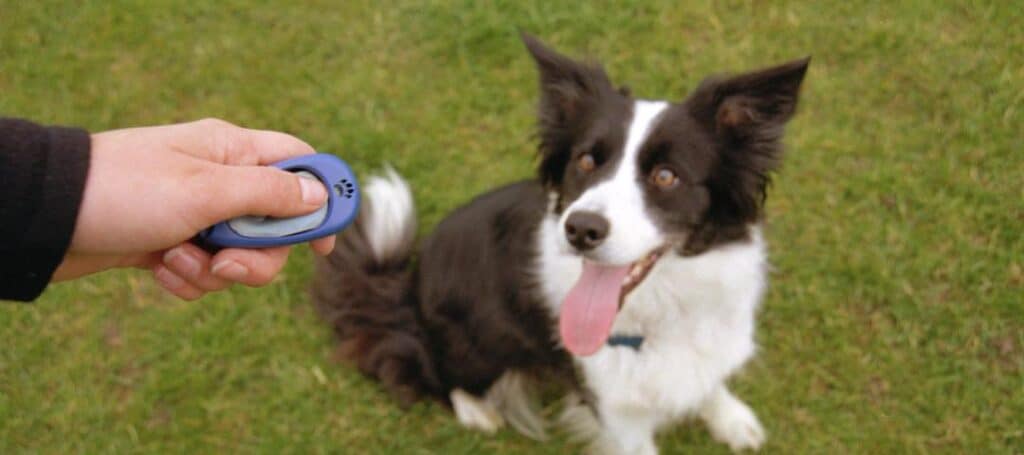
Hello All!
Last week we gave you an introduction to clicker training……. This week we will review and got in a bit greater depth.
How does clicker training work?
Clicker training depends on the fact that animals learn by association. The sound of a click means absolutely nothing to a dog to begin with, but when your dog realizes that every time they hear the click, they get a reward of some kind, they begin to pay very close attention and try to work out what they were doing when they heard the click and how they can make it happen again.
The process is:
1. Get the behaviour
2. Mark the behaviour with a click
3. Follow up with a reward
Think of the moment you click as being like a camera shutter; it captures a snapshot, with great precision, of the exact moment your dog did the right behaviour. This precision and clarity is what makes clicker training so special and means that you can train a dog to understand what you want much, much faster. Once a behaviour is learned, you do not need to continue to use the clicker.
Why can’t I just use my voice or make a different sound?
You can. Many people use the word “yes” or make a click noise with their mouth as a marker word or sound. This is still much better than treats alone, it is not as effective and does not achieve the same clarity as using a clicker. However hard we try, our voices change all the time in pitch and convey our emotions but the click sounds exactly the same every time. A conditioned marker word is useful as a backup if you can’t find your clicker or don’t have it with you.
Why use a clicker?
Without using a clicker or marker, your dog may not connect the reward with the action that you intended. For example, if you are training your dog to sit; the dog sits and you say “good dog!!” and move to deliver the treat to the dog and the dog stands up, comes towards you, puts their paws up on you to get to the treat faster, how does the dog know precisely which of those actions they were being rewarded for? With repetition, they will eventually connect that it was the sitting that earned them the reward, but it may take longer than it would with the use of a clicker or marker.
How to use the clicker.
Step 1 – Charging the clicker. The first step when you introduce the clicker to your dog is to go through a process called “charging” or “loading” the clicker; to build meaning to the sound of the click. This process is very simple, just press the clicker to make the sound, then follow up with something your dog really loves such as a great treat. After lots of repetitions, you will begin to see that your dog visibly startles in anticipation once they hear the click. It is at this point that we can safely assume they are beginning to understand what it means.
Step 2 – Try it out on behaviours your dog already knows. If your dog already knows how to sit, try practising this behaviour using the clicker to work on your timing. You want your dog to hear the click at the exact moment their rear end touches the ground and follow the click with a reward.
Step 3 – Try teaching a new behaviour
Luring
The clicker gives you many choices for teaching new behaviours. The most commonly used method is to lure the dog with a treat to get the action, mark the action with the clicker and then follow the click by rewarding with a food treat.
Shaping
Shaping is where you use the clicker to mark and reward approximations towards the final action you want your dog to perform, breaking it down into tiny pieces, like a puzzle. For example, if you want to teach your dog to go to their bed, you could shape the behaviour by clicking and rewarding your dog for just looking at the bed, then for taking just one step towards the bed etc. and build it up gradually – a bit like a game of “hot and cold”.
Capturing
You can simply capture behaviours as they happen naturally using the clicker. If you are struggling to teach your dog how to lie down by luring them, when you see your dog lying down on their own you could click and reward them and start to add a word to this behaviour.
Rules of the clicker
Only click once and follow up with a reward, even if your dog has just done something amazing, resist the urge to click multiple times as this will just muddy the waters for your dog.
Always reward after you click – if you click and no reward follows, you decrease the power of the clicker as a training tool and reduce its powerful meaning to the dog. Typically as long as you click at the right time 80% of the time the dog will grasp the behaviour that you are trying to teach them.
Do not use the clicker like a remote control. There is no need to point it at your dog and it is better not to click near the ears of your dog as the sound can be quite loud.
Do not click and treat simultaneously. We want the dog to understand that a click marks the behaviour and a reward then follows, not that both happen at the same time. After clicking, you have around a 20 second window to follow up with a reward before the dog no longer associates their behaviour with the consequence.
.
